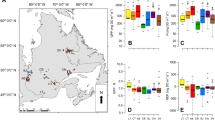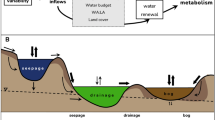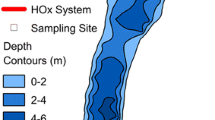Abstract
Climate change alters hydrologic regimes, including their variability. Effects will be pronounced in aquatic ecosystems, where resource subsidies (e.g., nutrients, carbon) drive key ecosystem processes. However, we know little about how changing hydrologic regimes will modulate the spatiotemporal dynamics of lake biogeochemistry and ecosystem metabolism. To address this, we quantified ecosystem metabolism and nutrient dynamicsat high spatial resolution in Acton Lake, a hyper-eutrophic reservoir in the Midwestern US. We captured two consecutive growing seasons with markedly different watershed discharge and nutrient loading. Temporal variability often exceeded spatial variability in both wet and dry years. However, relative spatial variability was higher in the dry year, suggesting that internal processes are more important in structuring spatial dynamics in dry years. Strikingly, marked differences in watershed discharge and nutrient loading between years produced relatively small differences in many lake metrics, suggesting resilience to hydrologic variability. We found little difference in gross primary productivity between wet and dry years, but ecosystem respiration was higher in the wet year, shifting net ecosystem production below zero. Discrete storm events produced strong, yet ephemeral and spatially explicit effects, reflective of the balance of stream input and discharge over the dam. Increases in limiting nutrients were restricted to near stream inlets and returned to pre-storm baseline within days. Ecosystem metabolism was suppressed during storm events, likely due to biomass flushing. Understanding how changing hydrologic regimes will mediate spatiotemporal dynamics of ecosystem metrics is paramount to preserving the ecological integrity and ecosystem services of lakes under future climates.












Similar content being viewed by others
References
Abell JM, Hamilton DP. 2014. Biogeochemical process and phytoplankton nutrient limitation in the inflow transition zone of a large eutrophic lake during a summer rain event. Ecohydrology 8:243–62.
Adrian R, O’Reilly CM, Zagarese H, Baines SB, Hessen DO, Keller W, Livingstone DM, Sommaruga R, Straile D, Van Donk E, Weyhenmeyer GA, Winder M. 2009. Lakes assentinels of climate change. Limnology and Oceanography 54:2283–97.
Andersen IM, Williamson TJ, González MJ, Vanni MJ. 2019. Nitrate, ammonium, and phosphorus driveseasonal nutrient limitation of chlorophytes, cyanobacteria, and diatoms in a hyper-eutrophic reservoir. Limnology and Oceanography, in press.
Aufdenkampe AK, Mayorga E, Raymond PA, Melack JM, Doney SC, Alin SR, Aalto RE, Yoo K. 2011. Riverine coupling of biogeochemical cycles between land, oceans, and atmosphere. Frontiers in Ecology and the Environment 9:53–60.
Byun K, Chiu CM, Hamlet AF. 2019. Effects of 21st century climate change on seasonal flow regimes and hydrological extremes over the Midwest and Great Lakes region of the US. Science of the Total Environment 650:1261–77.
Canty A, Ripley B. 2017. boot: Bootstrap R (S-Plus) functions. R Package Version 1.3-20.
Carpenter SR, Cole JJ, Pace ML, Van de Bogert M, Bade DL, Bastviken D, Gille CM, Hodgson JR, Kitchell JF, Kritzberg ES. 2005. Ecosystem subsidies: terrestrial support of aquatic food webs from 13C addition to contrasting lakes. Ecology 86:2737–50.
Cole JJ, Prairie YT, Caraco NF, McDowell WH, Tranvik LJ, Striegl RG, Duarte CM, Kortelainen P, Downing JA, Middelburg JJ, Melack J. 2007. Plumbing the global carbon cycle: integrating inland waters into the terrestrial carbon budget. Ecosystems 10:171–84.
Dai S, Shulski MD, Hubbard KG, Takle ES. 2015. A spatiotemporal analysis of Midwest US temperature and precipitation trends during the growing season from 1980 to 2013. International Journal of Climatology 36:517–25.
Davison AC, Hinkley DV. 1997. Bootstrap methods and their applications. Cambridge: Cambridge University Press.
Da Silva CA, Train S, Rodrigues LC. 2005. Phytoplankton assemblages in a Brazilian subtropical cascading reservoir system. Hyrdobiologia 537:99–109.
Deemer BR, Harrison JA, Li S, Beaulieu JJ, DelSontro T, Barros N, Bezerra-Neto JF, Powers SM, dos Santos MA, Arie Vonk J. 2016. Greenhouse gas emissions from reservoir water surfaces: a new global synthesis. Bioscience 66:949–64.
Demaria EM, Roundy JK, Wi S, Palmer RN. 2016. The effects of climate change on seasonal snowpack and the hydrology of the Northeastern and Upper Midwest United States. Journal of Climate 29:6527–41.
Einola E, Rantakari M, Kankaala P, Kortelainen P, Ojala A, Pajunen H, Mäkelä S, Arvola L. 2011. Carbon pools and fluxes in a chain of five boreal lakes: a dry and wet year comparison. Journal of Geophysical Research 116:G03009.
Ford DE. 1990. Reservoir transport processes. In: Thornton KW, Kimmel BL, Payne FE, Eds. Reservoir Limnology: Ecological Perspectives. New York: John Wiley & Sons Inc. p 15–41.
Gallardo B, Español C, Comin FA. 2012. Aquatic metabolism short-term response to the flood pulse in a Mediterranean floodplain. Hydrobiologia 693:251–64.
Gilling DP, Nejstgaaard JC, Berger SA, Grossart HP, Kirillin G, Penske A, Lentz M, Casper P, Sareyka J, Gessner MO. 2017. Thermocline deepening boosts ecosystem metabolism: evidence from a large-scale lake enclosure experiment simulating a summer storm. Global Change Biology 23:1448–62.
Gräler B, Pebesma E, Heuvelink G. 2016. Spatio-temporal interpolation using gstat. The R Journal 8:204–18.
Green PA, Vörösmarty CJ, Harrison I, Farrell T, Sáenz L, Fekete BM. 2015. Freshwater ecosystem services supporting human: pivoting from water crisis to water solutions. Global Environmental Change 34:108–18.
Grossiord C, Sevanto S, Adams HD, Collins AD, Dickman LT, McBranch N, Michaleetz ST, Stockton EA, Vigil M, McDowell NG. 2017. Precipitation, not air temperature, drives functional response of trees in semi-arid ecosystems. Journalof Ecology 105:163–75.
Havens KE, Ji G, Beaver JR, Fulton RSIII, Teacher CE. 2017. Dynamics of cyanobacteria blooms are linked to the hydrology of shallow Florida lakes and provide insight into possible impacts of climate change. Hydrobiologia 829:43–59.
Hayes NM, Vanni MJ, Horgan MJ, Renwick WH. 2015. Climate and land use interactively affect lake phytoplankton nutrient limitation status. Ecology 92:392–402.
Karl TR, Knight RW. 1998. Secular trends of precipitation amount, frequency, and intensity in the United States. Bulletin of the American Meteorological Society 79:231–41.
Kaushal SS, Likens GE, Jaworski NA, Pace ML, Sides AM, Seekell D, Belt KT, Secor DH, Wingate RL. 2010. Rising stream and river temperatures in the United States. Frontiers in Ecology and the Environment 8:461–6.
Kelly PT, González MJ, Renwick WH, Vanni MJ. 2018a. Increased light availability and nutrient cycling by fish provide resilience against reversing eutrophication in an agriculturally impacted reservoir. Limnology and Oceanography 63:2647–60.
Kelly PT, Vanni MJ, Renwick WH. 2018b. Assessing uncertainty in annual nitrogen, phosphorus, and suspended sediment load estimates in three agricultural streams using a 21-year dataset. Environmental Monitoring Assessment 190:91.
Kimmel BL, Lind OT, Paulson LJ. 1990. Reservoir primary production. In: Thornton KW, Kimmel BL, Payne FE, Eds. Reservoir Limnology: Ecological Perspectives. New York: John Wiley & Sons Inc. p 133–93.
Kratz TK, Deegan LA, Harmon ME, Lauenroth WK. 2003. Ecological variability in space and time: insights gained from the US LTER program. Bioscience 53:57–67.
Kratz TK, MacIntyre S, Webster KE. 2006. Causes and consequences of spatial heterogeneity in lakes. In: Lovett GM, Jones CG, Turner MG, Weathers KC, Eds. Ecosystem function in heterogeneous landscapes. New York: Springer. p 329–46.
Knapp AK, Hoover DL, Wilcox KR, Avolio ML, Koerner SE, La Lierre KJ, Loik ME, Luo Y, Sala OE, Smith MD. 2015. Characterizing differences in precipitation regimes of extreme wet and dry years: Implications for climate change experiments. Global Change Biology 21:2624–33.
Knoll LB, Vanni MJ, Renwick WH. 2003. Phytoplankton primary production and photosynthetic parameters in reservoirs along a gradient of watershed land use. Limnology and Oceanography 48:608–17.
Knoll LB, Vanni MJ, Renwick WH, Dittman EK, Gephart JA. 2013. Temperate reservoirs are large carbon sinks and small carbon sources: results from high-resolution carbon sinks. Global Biogeochemical Cycles 27:52–64.
Pathak P, Kalra A, Ahmad S. 2016. Temperature and precipitation changes of the Midwestern United States: implications for water management. International Journal of Water Resources Development 33:1003–19.
Pebesma EJ. 2004. Multivariable geostatistics in S: the gstat package. Computers & Geosciences 30:683–91.
Natchimuthu S, Sundgren I, Gålfalk M, Klemedtsson L, Bastviken D. 2016. Spatiotemporal variability of lake pCO2 and CO2 fluxes in a hemiboreal catchment. Journal of Geophysical Research: Biogeosciences 122:30–49.
Naz BS, Kao S-C, Ashfaq M, Gao H, Rastogi D, Gangrade S. 2018. Effects of climate change on streamflow extremes and implications for reservoir inflow in the United States. Journal of Hydrology 556:359–70.
Larsen S, Muehlbauer JD, Marti E. 2016. Resource subsidies between stream and terrestrial ecosystems under global change. Global Change Biology 22:2489–504.
Marcarelli AM, Baxter CV, Mineau MM, Hall RO. 2011. Quantity and quality: unifying food web and ecosystem perspectives on the role of resource subsidies in freshwaters. Ecology 92:1215–25.
R Core Team 2018. R: A language and environment for statistical computing. R Foundation for Statistical Computing, Vienna, Austria. https://www.R-project.org/.
Renwick WH, Vanni MJ, Zhang Q, Patton J. 2008. Water quality trends and changing agricultural practices in a Midwest U.S. watershed 1994–2006. Journal of Environmental Quality 37:1862–74.
Renwick WH, Vanni MJ, Fisher TJ, Morris EL. 2018. Stream nitrogen, phosphorus, and sediment concentrations show contrasting long-term trends associated with agricultural change. Journalof Environmental Quality 47:1513–21.
Roelke DL, Gable GM, Valenti TW, Grover JP, Brooks BW, Pinckney JL. 2010. Hydraulic flushing as a Prymnesium parvum bloom-terminating mechanism in a subtropical lake. Harmful Algae 9:323–32.
Sadro S, Melack JM, MacIntyre S. 2011. Spatial and temporal variability in the ecosystem metabolism of a high-elevation lake: integrating benthic and pelagic habitats. Ecosystems 14:1123–40.
Sadro S, Melack JM. 2012. The effect of an extreme rain event on the biogeochemistry and ecosystem metabolism of an oligotrophic high-elevation lake. Arctic, Antarctic, and Alpine Research 44:222–31.
Sinha E, Michalak AM, Balaji V. 2017. Eutrophication will increase during the 21st century as a result of climate change. Science 357:405–8.
Stockwell JD, Doubek JP, Adrian R, Anneville O, Carey CC, Carvalho L, De Senerpont Domis LN, Dur G, Frassl MA, Grossart H-P, Ibelings BW, Lajeunesse MJ, Lewandowska AM, Llames ME, Matsuzaki S-IS, Nodine ER, Nõges P, Patil VP, Pomati F, Rinke K, Rudstam LG, Rusak JA, Salmaso N, Seltmann CT, Straile D, Thackeray SJ, Thiery W, Urrutia-Cordero P, Venail P, Verburg P, Woolway RI, Zohary T, Andersen MR, Bhattacharya R, Hejzlar J, Janatian N, Kpodonu ATNK, Williamson TJ, Wilson HL. 2020. Storm impacts on phytoplankton community dynamics in lakes. Global Change Biology 00:1–27.
Tranvik LJ, Downing JA, Cotner JB, Loiselle SA, Striegl RG, Ballatore TJ, Dillon P, Finlay K, Fortino K, Knoll LB, Kortelainen PL, Kutser T, Larsen S, Laurion I, Leech DM, McCallister SL, McKnight DM, Melack JM, Overholt E, Porter JA, Prairie Y, Renwick WH, Roland F, Sherman BS, Schindler DW, Sobek S, Tremblay A, Vanni MJ, Verschoor AM, von Wachenfeldt E, Weyhenmeyer GA. 2009. Lakes and reservoirs as regulators of carbon cycling and climate. Limnology and Oceanography 54:2298–314.
Thornton KW. 1990. Perspectives on reservoir limnology. In: Thornton KW, Kimmel BL, Payne FE, Eds. Reservoir Limnology: Ecological Perspectives. New York: John Wiley & Sons Inc. p 1–14.
U.S. National Climate Assessment 2013. Midwest Region. www.gloabalchange.gov
Vachon D, del Giorgio PA. 2014. Whole-lake CO2 dynamics in response to storm events in two morphologically different lakes. Ecosystems 17:1338–53.
Van de Bogert MC, Bade DL, Carpenter SR, Cole JJ, Pace ML, Hanson PC, Langman OC. 2012. Spatial heterogeneity strongly affects estimates of ecosystem metabolism in two north temperate lakes. Limnology and Oceanography 57:1689–700.
Vanni MJ, Renwick WH, Headworth JL, Auch JD, Schaus MH. 2001. Dissolved and particulate nutrient flux from three adjacent agricultural watersheds: a five-year study. Biogeochemistry 54:85–114.
Vanni MJ, Andrews JS, Renwick WH, GonzálezMJ Noble SJ. 2006. Nutrient and light limitation of reservoir phytoplankton in relation to storm-mediated pulses in stream discharge. Archivfür Hydrobiologie 167:421–45.
Walz N, Welker M. 1998. Plankton development in a rapidly flushed lake in the River Spree system (Neuendorfer See, Northeast Germany). Journal of Plankton Research 20:2071–87.
Weyhenmeyer GA, Willén E, Soneston L. 2004. Effects of an Extreme precipitation event on water chemistry and phytoplankton in the Swedish Lake Mälaren. Boreal Environment Research 9:409–20.
Wilcox KR, Blair JM, Smith MD, Knapp AK. 2016. Does ecosystem sensitivity to precipitation at the site-level conform to regional-scale predictions? Ecology 97:561–8.
Williamson TJ, Vanni MJ, GonzálezMJ Renwick WH, Bremigan MT, Conroy JD. 2018. The importance of nutrient supply by fish excretion and watershed streams to a eutrophic lake varies with temporal scale over 19 years. Biogeochemistry 140:233–53.
Winslow LA, Zwart JA, Batt RD, Dugan HA, Woolway RI, Corman JR, Read JS. 2016. LakeMetabolizer: An R package for estimating lake metabolism from free- water oxygen using diverse statistical models. Inland Waters 6:622–36.
Zeileis A, Grothendieck G. 2005. Zoo: S3 infrastructure for regular and irregular time series. Journal of Statistical Software 14:1–17.
Zohary T, Ostrovsky I. 2011. Ecological impacts of excessive water level fluctuations in stratified freshwater lakes. Inland Waters 1:47–59.
Acknowledgements
We would like to thank Tera Ratliff and the Miami University (MU) Center for Aquatic and Watershed Science for nutrient analysis. This work was funded by the MU Academic Challenge program, as well as National Science Foundation Long-Term Research in Environmental Biology (LTREB) award DEB-1255159.
Author information
Authors and Affiliations
Corresponding author
Additional information
Author contributions
TJW and MJV conceived and designed the study with advice by WHR. TJW performed the research and data analysis. TJW wrote the manuscript with feedback from MJV and WHR.
Electronic supplementary material
Below is the link to the electronic supplementary material.
Rights and permissions
About this article
Cite this article
Williamson, T.J., Vanni, M.J. & Renwick, W.H. Spatial and Temporal Variability of Nutrient Dynamics and Ecosystem Metabolism in a Hyper-eutrophic Reservoir Differ Between a Wet and Dry Year. Ecosystems 24, 68–88 (2021). https://doi.org/10.1007/s10021-020-00505-8
Received:
Accepted:
Published:
Issue Date:
DOI: https://doi.org/10.1007/s10021-020-00505-8




